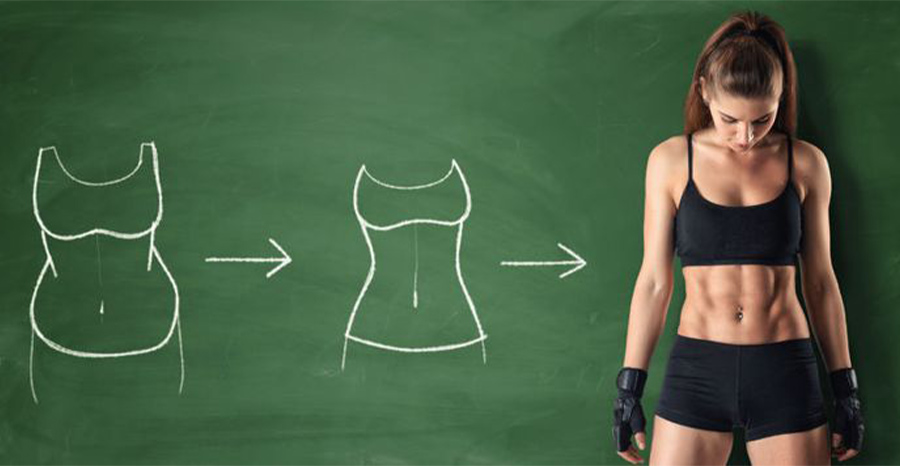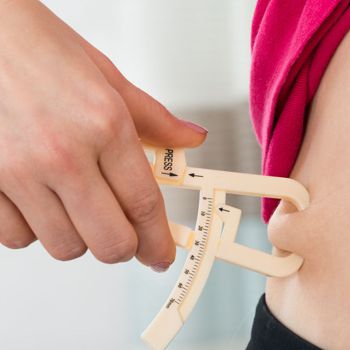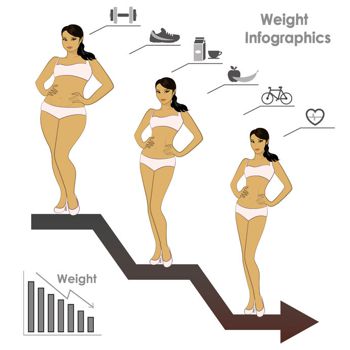
How to Measure Your Body Fat Percentage at Home
In my last article, I discussed fat loss vs. weight loss. We talk a lot about ‘losing weight’ but in fact losing weight is bad if a lot of what we’re losing is muscle mass. What we really want to do is lose fat and keep the muscle. But how much of our body is fat? To measure real progress, we need to know our body fat percentage. Some gyms and nutrition experts offer body fat percentage analyses done by a professional using expensive calipers, but these have a cost associated and pros who really know what they’re doing are hard to find. Many gyms have electrical resistance body fat measuring machines (also called “Bioelectrical Impedance”, or BIA), but these are grossly inaccurate.
Losing muscle is bad! What we really want to do is lose fat and keep (or even build) muscle. That takes proper attention to diet to be sure we’re getting enough protein.
Understanding Body Fat Percentage
Body fat percentage (BFP) is a measure of the amount of fat in your body relative to everything else, including muscles, tissues, water, and bones. This metric is often used as a more accurate indicator of fitness and health than body weight alone, because it provides a direct measurement of body composition.
Why It Matters
Knowing your body fat percentage can be crucial for several reasons:
- Health Assessment: High body fat levels are often associated with increased risks of cardiovascular diseases, diabetes, and other health conditions, while very low body fat can also pose health risks such as hormonal imbalances and reduced immune function.
- Fitness Goals: For athletes and individuals engaged in physical fitness, understanding body fat percentage can help tailor dietary and exercise programs for better performance and aesthetic goals.
- Weight Management: It helps to differentiate between weight loss that occurs due to fat loss versus muscle loss, guiding more effective weight management strategies.
Impact on Health and Fitness
The body fat percentage can significantly influence physical health and appearance. It affects everything from metabolic rate to physical endurance and muscle definition. Different ranges of body fat percentage are considered healthy depending on age, sex, and fitness level. For instance, athletes tend to have lower body fat percentages due to their higher muscle mass and physical demands.
Read Also: Elliptical machine vs treadmill
Why BioElectric Impedance (BIA) Doesn’t Work
BIA devices are measuring the resistance to a tiny electrical current which the machine shoots through your body. You may have seen the ones with two ‘footprints’ you stand on with your bare feet? Lots of gyms have them but these are the worst and so inaccurate you might as well guess. They send current up one leg and down the other, entirely missing your torso. If you tend to carry more fat on your torso than in your legs, it will be way off. There are a number of other, more technical reasons why this method doesn’t work but this article isn’t about that, so let’s get on to how to get a reasonably accurate measure at home.
Accurate Body Fat Measurement At Home
There are two primary methods for doing this. The first is to simply look at yourself naked in the mirror and compare (be honest now!) what you see to any of a number of images you can find online that will give you a pretty good ballpark. Just google ‘body fat percentage images’ and you’ll find a number to choose from. The better ones will have images for both males and females. While the second method I’m going to discuss is more accurate, later in this article I’ll talk about why the mirror method is my personal favorite.
Note that if your body fat is higher than 40% an accurate measure is pretty much impossible. Even the mirror method mentioned above won’t really get you in the ballpark. The problem here is that there’s so much fat it’s difficult to tell what your natural frame is. Two people could look the same in the mirror, but one has 20% more organ, bone and muscle mass than the other, so they could have very different body fat percentages.
See our products: half squat racks and power racks
Hydrostatic Weighing
You can measure your body fat if you’re in this category, but really the only way to do it is with an immersion test (hydrostatic weighing), which usually involves an expensive visit to a university or medical center. In this method your entire body is immersed in water, the displacement is measured to determine your body volume and the entire tank is weighed before and after your immersion. Because fat free mass (bone, muscle, organs) tends to be heavier than water but fat is lighter, by knowing the volume and weight differential they can calculate body density and from this come up with a pretty accurate measure of how much fat is on your body.
Using Calipers At Home

The second at-home method is to purchase a cheap pair of plastic calipers online. You can get one for a few bucks on Amazon. It’s OK if the measure you get from these isn’t completely accurate because unless you’re a competitive bodybuilder the actual number doesn’t really matter.
What we want to do is measure progress over time, and be able to calculate how much fat we’re losing vs. muscle. As long as the body fat percentage is going down, and most if not all of the weight we’re losing is fat, then we’re winning! If you want to splurge on a better set go ahead. The numbers you’ll get back will be consistently more accurate but it’s still going to be a ballpark. Also note that if you can pinch more than about 10 cm calipers won’t work.
A cheap pair of calipers and a few minutes to learn how to use them are all you need to get a reasonably accurate measure at home.
Using Calipers Properly
You also need to know how to use them. You can’t just measure your middle. You need to take measurements from a number of different spots on your body and for some of these you’ll need a friend to help, as you won’t be able to reach them on your own. I’m not going to cover the exact method, as again, there are plenty of instructions to be had online on how to do this properly. I just want you to understand that you can’t just use one site, and that the calipers don’t actually measure your body fat percentage. You have to do some math for that, and the online instructions you find will cover that for you. There’s a good basic guide here: https://www.wikihow.com/Use-Body-Fat-Calipers
Using Measuring Tape and Online Calculators
To accurately measure your body circumferences with a measuring tape, follow these steps:
- Prepare the Tape: Use a flexible measuring tape typically used for tailoring.
- Choose Consistent Points: Measure specific body parts at their widest or narrowest points consistently. Common measurements include the neck, shoulders, chest (under the armpits), waist (at the narrowest point or around the belly button), hips (at the widest part), and thighs.
- Maintain a Neutral Posture: Ensure the tape is snug but not compressing the skin, and maintain a natural stance without flexing the muscles.
- Repeat for Accuracy: Take each measurement at least twice to ensure accuracy.
How to Input These Measurements into Online Calculators to Estimate Body Fat Percentage? Once you have your measurements:
- Find a Reputable Online Calculator: Choose a calculator that requires multiple body part measurements for more accuracy, such as the U.S. Navy method or other fitness calculators.
- Enter Your Data: Input your measurements, along with other required information such as age, gender, and weight.
- Calculate and Interpret: The calculator will estimate your body fat percentage. Refer to health guidelines to understand whether your body fat percentage falls within a healthy range for your demographic.
These tools and methods offer a practical way to track changes in body composition, especially when more sophisticated methods are not available. However, it’s important to remember that the accuracy can vary based on the method and the precision with which measurements are taken.
Don’t Measure Too Often
Either the calipers or the mirror will get you a number you can start from. Retest about once a month to see how you’re doing and don’t get discouraged. If you fail to make progress, that just means you need to make further adjustments to your diet and exercise routine. Be persistent and sooner or later you’re going to be able to look at your calculations and see that you’re reducing your body fat percentage. If you’re also preserving your muscle mass, then you’ve got it licked. Keep going until you’ve got the body you want. Also, don’t make the mistake of testing too often. Sub-cutaneous water (water under the skin) is pretty much indistinguishable from fat and this can fluctuate a lot in a very short period of time, so if you measure too often you might just be measuring water retention changes.
The Best Method IMO

Earlier in this article I said I would talk about why the mirror method is my favorite, even though calipers are more accurate. The reason is simple. While there are obvious health benefits to losing weight, let’s be honest, we’re mostly doing it to improve how we look. If that’s what we’re after then the best measure is what we see in the mirror. If you want to really be able to track progress over time this way, take photos instead. Then you can line them up after a few months and really see your progress.
What we really care about is fat loss over time, so don’t worry too much about the accuracy of your fat percentage measurements. As long as you keep using the same method, you’ll be able to measure progress.
Shop a wide range of gym equipment at Dynamo Fitness Equipment in Australia. Visit our stores located in Perth, Sydney, Melbourne, and gym equipment Adelaide store, or explore our online fitness equipment store today. We offer a wide range of products suitable for both home and commercial use. Our stock includes free weights like Oympic weight, barbell weight set, dumbbell rack set, adjustable dumbbells, and weight plates, as well as a variety of home gym machines such as treadmills for sale, exercise bike Perth, and ellipticals. Additionally, they provide gym accessories for functional training, boxing, and conditioning
Will Dove
Latest posts by Will Dove (see all)
- Body Weight Training 2.0: Calisthenics - 22 Apr
- All About Protein Powders - 9 Apr
- Top 5 Fitness Trends for 2019 That You Should Try - 30 Mar
